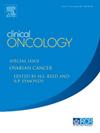老年和年轻肛门癌患者放化疗的临床结果和毒性分析:回顾性队列分析。
IF 3
3区 医学
Q2 ONCOLOGY
引用次数: 0
摘要
目的:老年肛门癌(AC)患者接受放化疗(CRT)的最佳管理仍然存在争议,特别是关于治疗耐受性和结果。本研究旨在比较接受标准CRT的老年和年轻患者的治疗结果和毒性特征。材料和方法:我们对2008年至2023年在我院接受CRT治疗的AC患者进行了16年的回顾性分析。共有61例患者被分为老年(≥65岁,n = 25)和年轻(结果:中位随访48个月(范围6-187)后,年轻和老年队列的完全缓解率分别为86.7%和95.2% (P = .395)。在48个月的中位随访中,4年OS在年轻患者中为72.3%,在老年患者中为68.7% (P = .845)。4年LRFS (77.7% vs 88.7%, P = .381)、MFS (83.8% vs 93.3%, P = .718)和PFS (77.7% vs 89.3%, P = .656)在队列间无显著差异。治疗完成率在年轻组和老年组分别为100%和98%。结论:老年AC患者与年轻患者在接受治疗意向CRT时表现出相当的治疗结果。我们的研究结果表明,在不同年龄组之间,完全缓解率、生存结果和较高的治疗完成率相当,精心管理的CRT在老年患者中既可行又有效。本文章由计算机程序翻译,如有差异,请以英文原文为准。
Clinical Outcomes and Toxicity Profile of Chemoradiotherapy in Older Versus Younger Patients With Anal Cancer: A Retrospective Cohort Analysis
Aims
The optimal management of older patients with anal cancer (AC) receiving chemoradiotherapy (CRT) remains controversial, particularly regarding treatment tolerance and outcomes. This study aimed to compare treatment outcomes and toxicity profiles between older and younger patients undergoing standard CRT.
Materials and methods
We conducted a 16-year retrospective analysis of AC patients treated with CRT at our institution between 2008 and 2023. A total of 61 patients were stratified into older (≥65 years, n = 25) and younger (<65 years, n = 36) patients. The primary objectives were to compare clinicopathological characteristics, treatment patterns, and outcomes between age groups, as well as to identify prognostic factors in patients with nonmetastatic squamous cell carcinoma of the anus (SCCA). Treatment toxicities were evaluated according to Common Terminology Criteria for Adverse Events (CTCAE). Survival analysis included overall survival (OS), locoregional recurrence-free survival (LRFS), metastasis-free survival (MFS), and progression-free survival (PFS). Analyses of survival curves were performed using the Kaplan-Meier method. Statistical significance was set at P < 0.05.
Results
After a median follow-up of 48 months (range, 6-187), complete response rates were 86.7% and 95.2% in younger and older cohorts, respectively (P = .395). At the 48-month median follow-up, 4-year OS was 72.3% in younger and 68.7% in older patients (P = .845). Four-year LRFS (77.7% vs 88.7%, P = .381), MFS (83.8% vs 93.3%, P = .718), and PFS (77.7% vs 89.3%, P = .656) showed no significant differences between cohorts. Completion of treatment reached 100% and 98% in younger and older groups. A pretreatment haemoglobin <11.7g/dL and an SCC ≥1.3 ng/mL were significant prognostic factors in the younger cohort only (P = .026 and P = .016, respectively).
Conclusion
Older patients with AC demonstrate comparable treatment outcomes to younger patients when receiving curative-intent CRT. With comparable complete response rates, survival outcomes, and high completion of treatment between age cohorts, our results demonstrate that carefully managed CRT is both feasible and effective in older patients.
求助全文
通过发布文献求助,成功后即可免费获取论文全文。
去求助
来源期刊

Clinical oncology
医学-肿瘤学
CiteScore
5.20
自引率
8.80%
发文量
332
审稿时长
40 days
期刊介绍:
Clinical Oncology is an International cancer journal covering all aspects of the clinical management of cancer patients, reflecting a multidisciplinary approach to therapy. Papers, editorials and reviews are published on all types of malignant disease embracing, pathology, diagnosis and treatment, including radiotherapy, chemotherapy, surgery, combined modality treatment and palliative care. Research and review papers covering epidemiology, radiobiology, radiation physics, tumour biology, and immunology are also published, together with letters to the editor, case reports and book reviews.
 求助内容:
求助内容: 应助结果提醒方式:
应助结果提醒方式:


